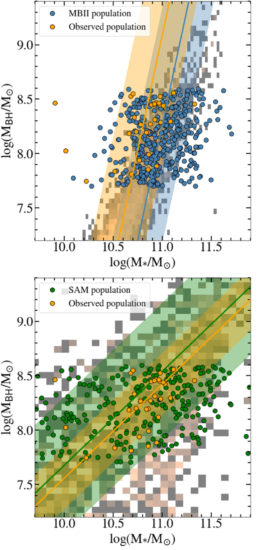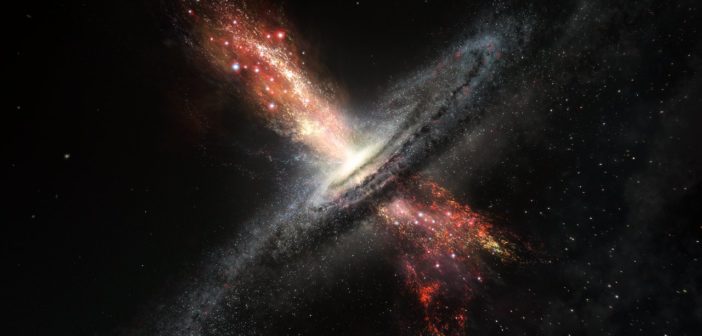The size of a supermassive black hole seems to track with the size of its host galaxy. But is this a statistical fluke, or is there a physical reason for the connection? Recent modeling provides new clues.
Growing Together

Composite image of Centaurus A, a galaxy whose appearance is dominated by the large-scale jets emitted by the supermassive black hole at its center. [ESO/WFI (Optical); MPIfR/ESO/APEX/A.Weiss et al. (Submillimetre); NASA/CXC/CfA/R.Kraft et al. (X-ray); CC BY 4.0]
But why the connection? How can the black hole know about the galaxy size around it, and vice versa? There are a few proposed explanations for the correlation between central-black-hole mass and its host galaxy’s stellar mass:
- It’s caused by active galactic nucleus (AGN) feedback.
In this scenario (recently described here), jets and winds from the accreting black hole can both trigger star formation and quench it by expelling extra gas — star-formation fuel — from the galaxy. This feedback causes the rate of star formation to roughly track the rate of black hole accretion. - It’s caused by black-hole growth and galaxy star formation both relying on the same fuel source.
If black-hole growth and galactic star formation both arise from the same source of fuel, then these two growths should correlate even if they don’t influence each other. One example of a fuel source that could cause sudden growth is a wet merger — the collision of two galaxies rich in gas. - It’s simply a consequence of statistics, and not caused by a physical mechanism.
A theorem known as the central limit theorem suggests that the correlation we observe could arise naturally as a statistical consequence of building up galaxies hierarchically from smaller structures over time. In this scenario, there’s no physical connection between the black hole and its host galaxy — it’s all statistics.
It’s a Matter of the Model
To test which of these explanations is most likely, we need to combine models with observations. A new study led by Xuheng Ding (University of California, Los Angeles) recently set out to do so.

Plots showing the correlation between black hole mass (MBH) and stellar mass of the host galaxy (M*. The actual observations are plotted in orange. The blue dots in the top plot show the simulated correlation from the hydrodynamic simulation; the green dots in the bottom plot show the simulated correlation from the semianalytic model. The hydro simulation provides a better match to the data. [Adapted from Ding et al. 2020]
The authors then compared these data to the outputs of two state-of-the-art models: a hydrodynamic simulation that focuses on AGN feedback, and a semianalytic model that is especially sensitive to wet galaxy-merger events.
Connecting via Feedback
The results of the authors’ models — in particular, the tightness of the modeled correlation between black-hole and galaxy size across redshifts — strongly support a physical mechanism driving the connection, rather than it being a consequence of statistics.
Of the two models, the hydrodynamic simulation better reproduced the scatter of the correlation, suggesting that AGN feedback may indeed be the driver ensuring that supermassive black holes grow at the same rate as their host galaxies. Observations out to higher redshifts — which may be possible with the upcoming James Webb Space Telescope — will help us further tease out the explanation for this intriguing link.
Citation
“Testing the Fidelity of Simulations of Black Hole–Galaxy Coevolution at z ~ 1.5 with Observations,” Xuheng Ding et al 2020 ApJ 896 159. doi:10.3847/1538-4357/ab91be


3 Comments
Pingback: From AAS NOVA: “The Link Between Black Holes and Their Galaxies” | sciencesprings
Pingback: Związek między czarnymi dziurami a ich galaktykami macierzystymi – PTMA Kraków
Pingback: Związek między czarnymi dziurami a ich galaktykami macierzystymi – Astronomia Śląska